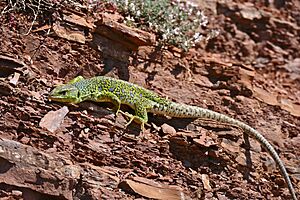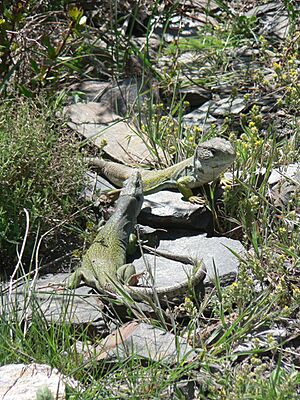Ocellated lizard facts for kids
Quick facts for kids Ocellated lizard |
|
|---|---|
 |
|
| Male | |
 |
|
| Female | |
| Conservation status | |
| Scientific classification | |
| Genus: |
Timon
|
| Species: |
lepidus
|
| Subspecies | |
|
T. l. ibericus (López-Seoane, 1884) |
|
 |
|
| Synonyms | |
|
|
The ocellated lizard or jewelled lizard (Timon lepidus) is a type of lizard. It belongs to the family called Lacertidae, which are often known as wall lizards. This special lizard lives only in southwestern Europe. People also call it the eyed lizard or jeweled lacerta, especially if it's sold as a pet.
Contents
Discover the Ocellated Lizard: Appearance and Size
The ocellated lizard is one of the biggest lizards in its family. An adult lizard can be about 30 to 60 cm (0.98 to 1.97 ft) long, including its tail. Some can even grow up to 90 cm (3.0 ft) and weigh more than 0.5 kg (1.1 lb). About two-thirds of its total length is just its tail! When they are newly hatched, baby lizards are only about 4 to 5 cm (1.5 to 2 in) long, not counting their tails.
This lizard is quite strong and has a rough, serrated collar around its neck. Male lizards have a wide head that makes them easy to spot. They also have thick, powerful legs with long, curved claws.
Colors and Patterns of the Jewelled Lizard
The main color on the lizard's back is usually green. However, some lizards might be grey or brownish, especially on their heads and tails. They have black speckles that can form cool patterns, sometimes looking like connected rosettes.
The lizard's belly is yellowish or greenish. Both male and female lizards have bright blue spots along their sides. The blue spots on males are usually much brighter than on females. Young lizards can be green, grey, or brown. Their spots are yellowish or white, and often have black edges.
Where Do Ocellated Lizards Live?
The ocellated lizard is native to southwestern Europe. You can find it all over the Iberian Peninsula, which includes Spain, Portugal, and Gibraltar. It also lives in some parts of southern France and the very northwestern tip of Italy.
Subspecies and Their Homes
There are different types, or subspecies, of the ocellated lizard:
- Timon lepidus ibericus: This subspecies lives in the northwestern part of the Iberian Peninsula, in Spain and Portugal.
- Timon lepidus lepidus
- Timon lepidus oteroi
Ocellated Lizard Habitat and Lifestyle
You can find Timon lepidus in many different places, both wild and farmed. They live from sea level up to about 2,100 m (6,900 ft) high in southern Spain. They are not very common at higher altitudes.
These lizards prefer dry, bushy areas. This includes open woodlands, scrublands, old olive groves, and vineyards. Sometimes, they are found in more open, rocky, or sandy spots. You might even see them warming up in the sun on roadsides!
The ocellated lizard usually stays on the ground. However, it is a good climber and can climb on rocks and in trees. It can also dig its own holes. Sometimes, it uses burrows that rabbits have left behind.
What Do Ocellated Lizards Eat?
The ocellated lizard mainly eats large insects, especially beetles, and snails. They also sometimes raid birds' nests for eggs or chicks. Occasionally, they will eat other reptiles, frogs, and small mammals. In dry areas, they also eat fruits and other plant material.
Reproduction and Life Cycle
Ocellated lizards usually breed in late spring or early summer. During the spring, male lizards become very territorial. They will fight with other males during the breeding season to protect their space and find a mate.
About three months after mating, the female lizard lays her eggs. This usually happens in June or July. She can lay up to 22 eggs. She hides them under stones, logs, in leaf litter, or in loose, damp soil. In dry areas, she tends to lay fewer, but larger, eggs. The eggs hatch in about eight to 14 weeks. These lizards become old enough to have their own babies when they are two years old.
Protecting the Ocellated Lizard
The ocellated lizard is listed as "Near Threatened" on The IUCN Red List of Threatened Species. This means that while it's not in immediate danger, its population could become threatened in the future if we don't protect it. As of 2011[update], this species has been protected in Spain. This means it is against the law to capture or trade these lizards there.



